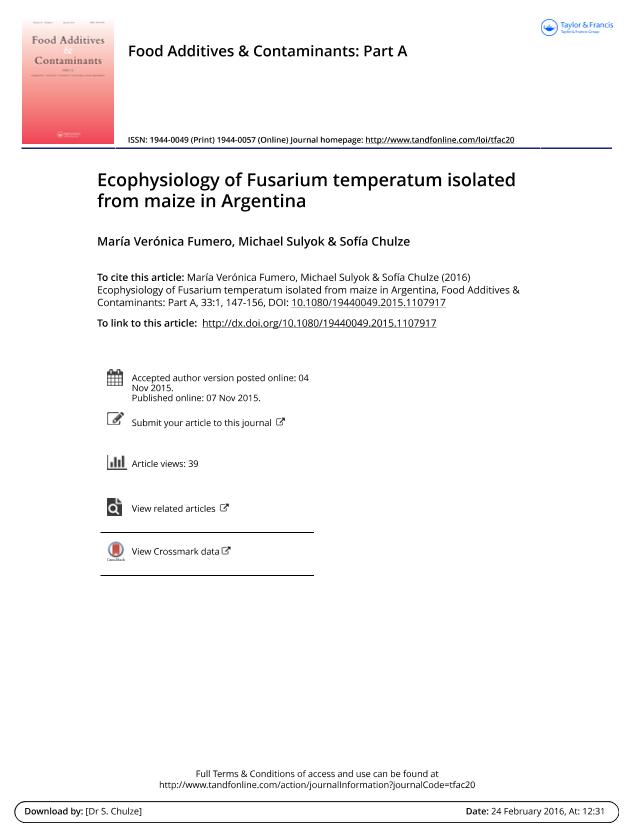Mostrar el registro sencillo del ítem
dc.contributor.author
Fumero, María Verónica

dc.contributor.author
Sulyok, Michael

dc.contributor.author
Chulze, Sofia Noemi

dc.date.available
2022-12-02T12:44:48Z
dc.date.issued
2016-09
dc.identifier.citation
Fumero, María Verónica; Sulyok, Michael; Chulze, Sofia Noemi; Ecophysiology of Fusarium temperatum isolated from maize in Argentina; Taylor & Francis Ltd; Food Additives and Contaminants; 33; 1; 9-2016; 147-156
dc.identifier.issn
0265-203X
dc.identifier.uri
http://hdl.handle.net/11336/179961
dc.description.abstract
The effect of water activity (aw = 0.95, 0.98 and 0.995), temperature (15, 25 and 30°C), incubation time (7, 14, 21 and 28 days), and their interactions on growth and moniliformin (MON), beauvericin (BEA), fusaproliferin (FUS) and fumonisin B1 (FB1) production by two strains of Fusarium temperatum isolated from Argentinean maize were determined in vitro on sterile layers of maize grains. The results showed that there was a wide range of conditions for growth and mycotoxins production by F. temperatum. Both strains were found to grow faster with increasing aw and at 30°C. In relation to mycotoxin production, the two strains produced more FUS than the other mycotoxins regardless of aw or temperature evaluated (maximum = 50 000 μg g−1). For FUS, MON and BEA, the maximum levels were observed at 0.98 aw and 30°C (50 000, 5000 and 2000 μg g−1 respectively). The lowest levels for these three mycotoxins were detected at 15°C and 0.95 aw (1700 and 100 μg g−1 for FUS and MON respectively), and at 0.98 aw (400 μg g−1 for BEA). The maximum levels of FB1 were produced at 15°C and 0.98 aw (1000 μg g−1). At all aw and temperatures combinations evaluated there was an increase in toxin concentrations with time incubation. The maximum levels were detected at 21 days. Statistical analyses of aw, temperature, incubation time, and the two-and three-way interactions between them showed significant effects on mycotoxins production by F. temperatum. For its versatility on growth and mycotoxin production, F. temperatum represents a toxicological risk for maize in the field and also during grain storage.
dc.format
application/pdf
dc.language.iso
eng
dc.publisher
Taylor & Francis Ltd

dc.rights
info:eu-repo/semantics/openAccess
dc.rights.uri
https://creativecommons.org/licenses/by-nc-sa/2.5/ar/
dc.subject
ECOPHYSIOLOGY
dc.subject
FUMONISIN
dc.subject
BEAUVERICIN
dc.subject
MAIZE
dc.subject
FUSAPROLIFERIN
dc.subject.classification
Micología

dc.subject.classification
Ciencias Biológicas

dc.subject.classification
CIENCIAS NATURALES Y EXACTAS

dc.title
Ecophysiology of Fusarium temperatum isolated from maize in Argentina
dc.type
info:eu-repo/semantics/article
dc.type
info:ar-repo/semantics/artículo
dc.type
info:eu-repo/semantics/publishedVersion
dc.date.updated
2022-12-01T14:14:49Z
dc.identifier.eissn
1944-0057
dc.journal.volume
33
dc.journal.number
1
dc.journal.pagination
147-156
dc.journal.pais
Reino Unido

dc.journal.ciudad
Londres
dc.description.fil
Fil: Fumero, María Verónica. Universidad Nacional de Río Cuarto. Facultad de Ciencias Exactas, Fisicoquímicas y Naturales. Departamento de Microbiología e Inmunología; Argentina. Consejo Nacional de Investigaciones Científicas y Técnicas. Centro Científico Tecnológico Conicet - Córdoba; Argentina
dc.description.fil
Fil: Sulyok, Michael. University of Natural Resources and Life Sciences Vienna; Australia
dc.description.fil
Fil: Chulze, Sofia Noemi. Consejo Nacional de Investigaciones Científicas y Técnicas. Centro Científico Tecnológico Conicet - Córdoba; Argentina. Universidad Nacional de Río Cuarto. Facultad de Ciencias Exactas, Fisicoquímicas y Naturales. Departamento de Microbiología e Inmunología; Argentina
dc.journal.title
Food Additives and Contaminants

dc.relation.alternativeid
info:eu-repo/semantics/altIdentifier/doi/http://dx.doi.org/10.1080/19440049.2015.1107917
Archivos asociados
